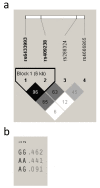No association of the polymorphisms of the frizzled-related protein gene with peak bone mineral density in Chinese nuclear families
- PMID: 20043861
- PMCID: PMC2806249
- DOI: 10.1186/1471-2350-11-1
No association of the polymorphisms of the frizzled-related protein gene with peak bone mineral density in Chinese nuclear families
Abstract
Background: The Wnt/beta-catenin signaling pathway plays an important role in skeletal development. Polymorphisms of frizzled-related protein (FRZB), an antagonist of this pathway, may generate variations in bone mineral density (BMD). In this study, we analyzed the association between FRZB genotypes and peak BMD variation in the spines and hips of two relatively large samples of Chinese female-offspring and male-offspring nuclear families.
Methods: We recruited 1,260 subjects from 401 female-offspring nuclear families and 1,296 subjects from 427 male-offspring nuclear families and genotyped four tagging single nucleotide polymorphisms (tagSNPs) (rs6433993, rs409238, rs288324, and rs4666865) spanning the entire FRZB gene. The SNPs rs288326 and rs7775, which are associated with hip osteoarthritis, were not selected in this study because of their low minor allele frequencies (MAFs) in Chinese people. The quantitative transmission disequilibrium test (QTDT) was used to analyze the association between each SNP and haplotype with peak BMD in female- and male-offspring nuclear families.
Results: In the female-offspring nuclear families, we found no evidence of an association between either single SNPs or haplotypes and peak BMD in the spine or hip. In the male-offspring nuclear families, no within-family association was observed for either SNPs or haplotypes, although a significant total association was found between rs4666865 and spine BMD (P = 0.0299).
Conclusion: Our results suggest that natural variation in FRZB is not a major contributor to the observed variability in peak BMD in either Chinese females or males. Because ethnic differences in the FRZB genotypes may exist, other studies in different population are required to confirm such results.
Figures

Similar articles
-
Polymorphisms in Wnt signaling pathway genes are associated with peak bone mineral density, lean mass, and fat mass in Chinese male nuclear families.Osteoporos Int. 2016 May;27(5):1805-15. doi: 10.1007/s00198-015-3457-7. Epub 2016 Jan 5. Osteoporos Int. 2016. PMID: 26733379
-
Association between low density lipoprotein receptor-related protein 2 gene polymorphisms and bone mineral density variation in Chinese population.PLoS One. 2011;6(12):e28874. doi: 10.1371/journal.pone.0028874. Epub 2011 Dec 9. PLoS One. 2011. PMID: 22174918 Free PMC article.
-
Polymorphisms in the human ALOX12 and ALOX15 genes are associated with peak bone mineral density in Chinese nuclear families.Osteoporos Int. 2012 Jul;23(7):1889-97. doi: 10.1007/s00198-011-1835-3. Epub 2011 Nov 17. Osteoporos Int. 2012. PMID: 22089472
-
No association between polymorphisms of peroxisome [corrected] proliferator-activated receptor-gamma gene and peak bone mineral density variation in Chinese nuclear families.Osteoporos Int. 2010 May;21(5):873-82. doi: 10.1007/s00198-009-1028-5. Epub 2009 Jul 31. Osteoporos Int. 2010. PMID: 19644638
-
Polymorphisms in the HOXD4 gene are not associated with peak bone mineral density in Chinese nuclear families.Acta Pharmacol Sin. 2010 Aug;31(8):977-83. doi: 10.1038/aps.2010.91. Acta Pharmacol Sin. 2010. PMID: 20686522 Free PMC article.
Cited by
-
Diametrical diseases reflect evolutionary-genetic tradeoffs: Evidence from psychiatry, neurology, rheumatology, oncology and immunology.Evol Med Public Health. 2015 Sep 9;2015(1):216-53. doi: 10.1093/emph/eov021. Evol Med Public Health. 2015. PMID: 26354001 Free PMC article. Review.
-
Association of ALOX15 gene polymorphisms with obesity-related phenotypes in Chinese nuclear families with male offspring.Acta Pharmacol Sin. 2012 Feb;33(2):201-7. doi: 10.1038/aps.2011.167. Acta Pharmacol Sin. 2012. PMID: 22301860 Free PMC article.
-
Contribution of the sclerostin domain-containing protein 1 (SOSTDC1) gene to normal variation of peak bone mineral density in Chinese women and men.J Bone Miner Metab. 2011 Sep;29(5):571-81. doi: 10.1007/s00774-010-0253-5. Epub 2011 Jan 8. J Bone Miner Metab. 2011. PMID: 21221677
-
Single-nucleotide polymorphisms in genes associated with the vitamin D pathway related to clinical and therapeutic outcomes of American tegumentary leishmaniasis.Front Cell Infect Microbiol. 2025 Jan 8;14:1487255. doi: 10.3389/fcimb.2024.1487255. eCollection 2024. Front Cell Infect Microbiol. 2025. PMID: 39844838 Free PMC article.
-
Polymorphisms in Wnt signaling pathway genes are associated with peak bone mineral density, lean mass, and fat mass in Chinese male nuclear families.Osteoporos Int. 2016 May;27(5):1805-15. doi: 10.1007/s00198-015-3457-7. Epub 2016 Jan 5. Osteoporos Int. 2016. PMID: 26733379
References
-
- Cummings SR, Kelsey JL, Nevitt MC, O'Dowd KJ. Epidemiology of osteoporosis and osteoporotic fractures. Epidemiol Rev. 1985;7:178–208. - PubMed
-
- Melton LJ III, Kan SH, Frye MA, Wahner HW, O'Fallon WM, Riggs BL. Epidemiology of vertebral fractures in women. Am J Epidemiol. 1989;129:1000–1011. - PubMed
-
- Deng HW, Chen WM, Conway T, Zhou Y, Davies KM, Stegman MR, Deng H, Recker RR. Determination of bone mineral density of the hip and spine in human pedigrees by genetic and life-style factors. Genet Epidemiol. 2000;19:160–177. doi: 10.1002/1098-2272(200009)19:2<160::AID-GEPI4>3.0.CO;2-H. - DOI - PubMed
Publication types
MeSH terms
Substances
LinkOut - more resources
Full Text Sources
Medical

